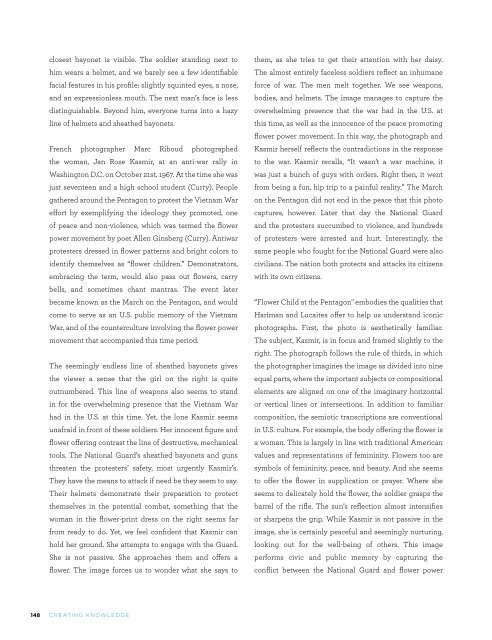UNDERGRADUATE
Ycb5305N2JX
Ycb5305N2JX
Create successful ePaper yourself
Turn your PDF publications into a flip-book with our unique Google optimized e-Paper software.
counterculture. The efforts of the flower power movement<br />
are positively represented: we find the innocent flower<br />
child on the right easier to empathize with than the<br />
faceless Guard on the left. The photograph validates<br />
the voices of those in opposition to the war. Beyond this<br />
historical moment, it also encourages the public to speak<br />
out in times of conflict. This image also emotional not<br />
only because of the interaction between Kasmir and the<br />
faceless Guard, but for the events we imagine occurring<br />
before and after the photo as well. As we will see with the<br />
photographs taken during Russia’s Orange Revolution and<br />
the more recent riots in Romania, these pictures embody<br />
comparable emotional and semiotic scenarios. Lastly,<br />
contradictions and crises are at the center of this picture,<br />
as represented by the emotional bodies and semiotic<br />
meaning of various compositional elements. The good,<br />
physically defenseless girl on the right promotes peace,<br />
while the evil, armed and protected National Guard seems<br />
to represent a fight for what they think is justice. This<br />
image selectively depicts one aspect and one perspective<br />
of the war, perhaps oversimplifying the seemingly twodimensional<br />
forces framed in such stark opposition.<br />
As I looked for information about this photograph,<br />
searching for terms such as flower, woman, peace, in<br />
various combinations, I came across a handful of other<br />
photos. These images interestingly mimic certain physical<br />
elements of the original “Flower Child at the Pentagon", as<br />
well as build on this iconic photograph’s visual rhetoric.<br />
By mimicking this image that is already recognized as<br />
representative of a certain era, and communicative of<br />
a specific ideology, that of peace, these other images<br />
are able to create a new, richer meaning of their own.<br />
Additionally, they create a dialogue between their own<br />
perspective, similar images emerging in times of chaos,<br />
and with the original itself.<br />
Flower Power<br />
Photographer Bernie Boston took a similar photo, Flower<br />
Power, in nearly the same time and space as “Flower<br />
Child at the Pentagon"—October 21, 1967, at a March on<br />
the Pentagon. 2 It is also in black and white, and depicts<br />
a man in a turtleneck sweater who places carnations<br />
down the barrels of soldiers’ rifles. The soldiers appear<br />
as anonymous as they did in “Flower Child", making it<br />
easy to understand the protesters as simply victims to<br />
this overpowering, ruthless, faceless war. The soldiers<br />
are only helmets, uniforms, and weapons. Other people<br />
stand behind the flowering man. They are unarmed,<br />
and seem to curiously peer into the crowd of soldiers.<br />
Interestingly, the man is also on the right, in the position<br />
of the benevolent side of this photograph. We do not see<br />
his face, however. He turns away from the camera and to<br />
our left. Kasmir is not alone, even though she appears<br />
to be in “Flower Child at the Pentagon". Other people<br />
at the same event that day similarly share flowers with<br />
the soldiers outside of the Pentagon. Both photographs<br />
capture the innocent flower child on the right, offering<br />
indicators of the movement they represent to the armed<br />
soldiers. These photographs serve as an American<br />
memory that conveys the conflict between the anti-war<br />
counterculture and the Vietnam War.<br />
Despite these apparent similarities, there are noteworthy<br />
differences that separate these two pictures, leading to<br />
one being more iconic than the other. For one, the framing<br />
of this second picture is noticeably more unconventional<br />
and nontraditional than “Flower Child". The camera faces<br />
downwards, capturing the tops of protesters’ and soldiers’<br />
heads. This framing disrupts our ability to emotionally<br />
relate to the image’s subject. We do not have the same<br />
intimacy with the subject as we did with Kasmir. We saw<br />
her eyes and her unique expression; here, the young man’s<br />
eyes are covered by his hair, and he is less vulnerable,<br />
surrounded by other protesters. The soldiers are also less<br />
intimidating. Rather than being uniformly lined up, they<br />
are scattered and unorganized. While this image certainly<br />
captures a similar crisis as “Flower Child at the Pentagon"<br />
and to some degree emotional and semiotic scenarios, it<br />
2 Flower Child can be viewed here:<br />
http://www.famouspictures.org/flower-power/.<br />
DEPAUL UNIVERSITY<br />
149


